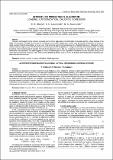| dc.contributor.author | Shalyi, Evgeny Evgenievich | |
| dc.contributor.author | Leonovich, Sergej Nikolaevich | |
| dc.contributor.author | Budrevich, Nelly Anatolyevna | |
| dc.coverage.spatial | Brest | |
| dc.date.accessioned | 2021-12-03T11:45:37Z | |
| dc.date.available | 2021-12-03T11:45:37Z | |
| dc.date.issued | 2021 | |
| dc.identifier.citation | Shalyi, E. E. Service life prediction’s algorithm: loading, carbonization, chloride aggression / E. E. Shalyi, S. N. Leonovich, N. A. Budrevich // Vestnik of Brest State Technical University. – 2021. – № 3 (126). – P. 17–20. | |
| dc.identifier.uri | https://rep.bstu.by/handle/data/24541 | |
| dc.description | Е. Е. Шалый, С. Н. Леонович, Н. А. Будревич. АЛГОРИТМ ПРОГНОЗИРОВАНИЯ СРОКА СЛУЖБЫ: НАГРУЗКА, КАРБОНИЗАЦИЯ, ХЛОРИДНАЯ АГРЕССИЯ | |
| dc.description.abstract | Corrosion reinforcement marine hydraulic structures due to chloride aggression and carbonization of concrete leads to a sharp decrease in the safety of the structure. The steel reinforcement will be subjected to a so-called depassivation process, once the chloride concentration on surface exceeds a certain threshold concentration, or the pH value in the protective layer of concrete decreases to a threshold value due to carbonation. Electrochemical reactions begin to occur with the formation of corrosion products with the penetration of oxygen on the steel reinforcement surface. This leads to cracking of the protective layer of concrete. It should also be taken into account that, due to corrosion mechanisms, the cross-sectional area of the reinforcement also decreases. The article suggests a method for predicting the complex degradation of reinforced concrete structures, taking into account various mechanisms of corrosion wear, which will allow developing effective ways to improve the durability and maintainability of structures operated in the marine environment. | |
| dc.language.iso | en | |
| dc.publisher | BrSTU | |
| dc.subject | structure | |
| dc.subject | concrete | |
| dc.subject | corrosion | |
| dc.subject | carbonation | |
| dc.subject | chloride aggression | |
| dc.subject | структура | |
| dc.subject | бетон | |
| dc.subject | коррозия | |
| dc.subject | карбонизация | |
| dc.subject | хлоридная агрессия | |
| dc.title | Service life prediction’s algorithm: loading, carbonization, chloride aggression | |
| dc.type | Статья (Article) | |
| dc.identifier.udc | 624.012.45.046 | |
| dc.abstract.alternative | Коррозионное армирование морских гидротехнических сооружений из-за хлоридной агрессии и карбонизации бетона приводит к резкому снижению сохранности конструкции. Стальная арматура подвергнется так называемому процессу депассивации, когда концентрация хлоридов на поверхности превысит определенную пороговую концентрацию или значение pH в защитном слое бетона снизится до порогового значения из-за карбонизации. Электрохимические реакции начинают протекать с образованием продуктов коррозии с проникновением кислорода на поверхность стальной арматуры. Это приводит к растрескиванию защитного слоя бетона. Также следует учитывать, что из-за механизмов коррозии площадь поперечного сечения арматуры также уменьшается. В статье предложен метод прогнозирования комплексной деградации железобетонных конструкций с учетом различных механизмов коррозионного износа, который позволит разработать эффективные способы повышения долговечности и ремонтопригодности конструкций, эксплуатируемых в морской среде. | |
| dc.identifier.doi | https://doi.org/10.36773/1818-1112-2021-126-3-17-20 | |
